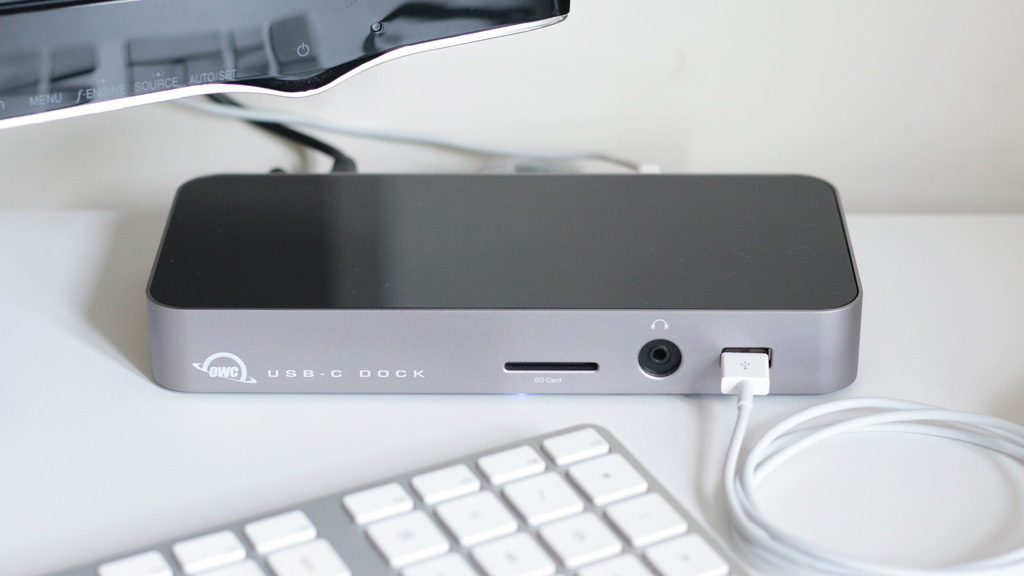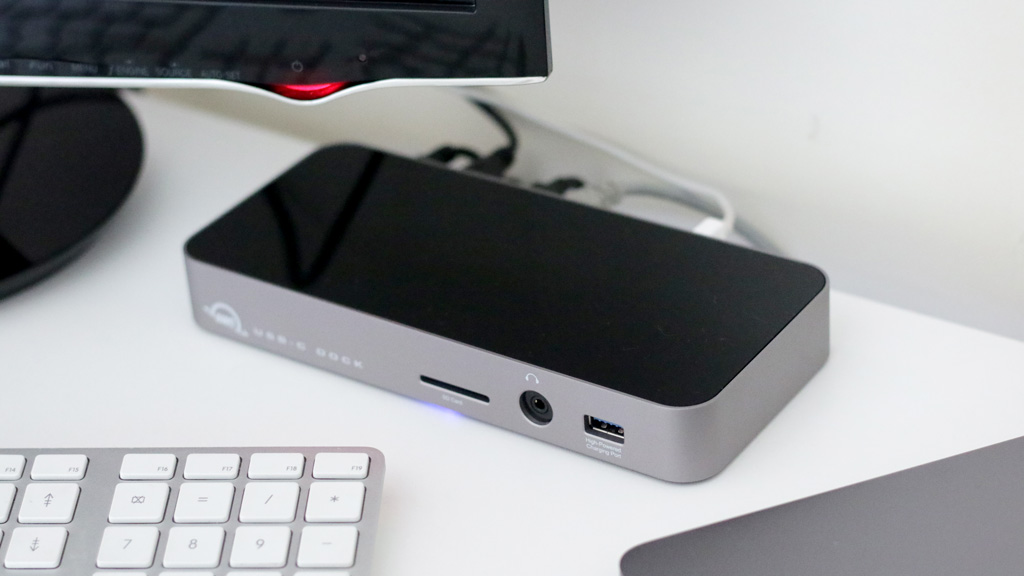OWC USB-C Dock
The desktop is dead, but the need to work at a desk, with a proper chair, good posture, a mouse, keyboard and plenty of screen real-estate most definitely isn’t.
While traditional business-laptop docks have often required ugly, proprietary ports with screw-in blanking plates or giant letterbox-like flaps on the bottom of your laptop, USB-C heralds a graceful and tidy standard alternative. With just one cable, a separate, neatly tucked away dock can now offer USB3 ports, video out, sound, SD card readers, Ethernet and- well pretty much virtually anything you’d normally connect to a USB port- in one tidy package. Couple this with USB-C’s power delivery options, and that one cable will also charge your laptop. That’s pretty nifty.
Without Apple’s push, USB-C might have taken a while to gain any traction. Other manufacturers have been playing it safe- welcoming USB-C alongside USB3, HDMI and other ports. The USB-C only MacBook and MacBook Pro have created demand for, and thus cemented a whole new market of exciting, single-cable dock products. Built originally for the MacBook, the OWC USB Type-C Dock is one of them.
At almost half the price but with most of the features, OWC’s USB Type-C Dock is a great cost-effective alternative to its upcoming Thunderbolt 3 sibling. While the Thunderbolt 3 dock is aimed at the MacBook Pro, and the professional user, the USB-C dock still offers plenty of ports for all but the most demanding uses.

I’ve had the OWC dock set up on a desk for a few weeks now- hooked up via HDMI to a monitor, and connected to a mouse and keyboard. Despite all its bells and whistles, by far its single most attractive feature is power delivery. Why? Because a second power adaptor is a phenomenally useful and convenient accessory to have for your Mac, but also a difficult cost to justify.
A 61W USB-C power supply from Apple, capable of powering a MacBook Pro, will set you back a whopping £69 (or ). The cable? Another £20 (or ). That’s about 0 compared to the 0 of the OWC dock. Sure, you can pick up a third party power supply for cheaper, but USB-C chargers are somewhat infamous for being a bit of a minefield, so you’d have to pick up a reputable branded one. NuPower’s is .99, which doesn’t save you much.
That extra step up from an official Apple power supply to an OWC USB-C Dock will net you a 60W power supply, SD card reader, HDMI port, 4x USB3 ports (one on the front, for charging/syncing your phone), a USB-C port, Gigabit Ethernet, and a 3.5mm audio input/output all in a package you can leave at your desk so your Apple supply need never come out of your travel bag. That’s a heck of a lot of bang for your buck, and I don’t think I need to illustrate just what the individual dongle equivalent might look like. Let’s just suffice with one word; spaghetti.

Having all of this functionality in one single device can lead to some gotchas, though. If you’re often using SD cards and external hard disks you must take extra care to eject them before yanking the power/data/everything cable. In my experience Macs can get themselves in a bit of a twist with external hard drives and, while they’re easy enough to repair if you manage to corrupt them, it’s a problem you’ll want to train yourself carefully to avoid. As for sound and video, that’s fine, your computer wont care if you yank them suddenly!
That said, I’ve noticed the MacBook Pro (which I borrowed from D) certainly has some issues with display outputs connected via USB-C and Thunderbolt 3 from time to time. This is absolutely not isolated to OWC’s dock, I’ve had tested various different dongles and adaptors, a few of which have required the MacBook Pro to be rebooted before they’ll work for the first time. It happens, fortunately infrequently.
Functionality aside, the OWC Dock is exceptionally well presented. It’s wrapped with aluminium and available in 3 colours, keyed to each of Apple’s own colour choices, it has a gloss black top (admittedly, aluminium would have been nicer to keep marks and fingerprints at bay), and bottom and separates all the inputs and outputs onto the front and back edge depending on how you’re likely to use them. I’d question the presence of the audio jack on the front, since I think it’s a little ugly and would much rather have used it to permanently connect some decent desktop speakers, but it’ll certainly prepare you for when Apple eventually drop the 3.5mm jack from their laptops.
Rubber feet keep it shy of the desk, and OWC have cleverly placed the status LEDs on the bottom so they don’t glare obnoxiously into your eyes but, instead, bounce subtly off your desk. It’s a nice effect.

Overall, I would heartily recommend this dock. It looks fantastic, does what it says on the tin and is a much, much neater and more cost-effective solution than a spaghetti mess of adaptors and an additional power supply. It’s also cheaper than a full-blown Thunderbolt 3 dock, and may be the right choice if you don’t need dual displays (or three, if you count the laptop display).
I’d love this kind of dock setup for my Razer Blade so I didn’t have to keep yanking multiple cables- it really doesn’t want to work with the OWC dock, though, which is a shame because the Skull Canyon NUC I’m testing at the moment worked absolutely fine with it. This is a big issue with USB Type-C and Thunderbolt 3 at the moment, despite being standards they’re becoming notorious for compatibility issues and not all ports are created equal. Suffice to say, if you can’t find an article online stating a particular dock works with your computer (including this one), or the manufacturer doesn’t state explicitly that it does, beware. There’s a chance you might have trouble with it.
If I’d decided to go with a MacBook Pro instead of the Razer Blade, I’d absolutely have a dock at home and at work, it’s really quite a hassle lugging my power supply around! Or, rather, crawling under my desk to plug it in every day. I treated myself to a C-5 Cloverleaf cable recently to fix that, though 😉
Tested with:
- 13″ TouchBar MacBook Pro: Working + Power
- Intel Skull Canyon NUC: Working (Cannot be powered over USB-C)